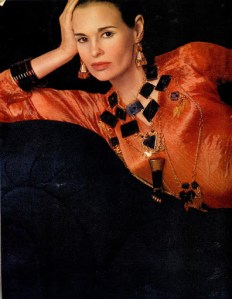This morning whilst still feeling a little fuzzy headed (or rather fuzzy eyed as my eyes decided to have a hangover this morning) I was reminded of one of my all time favourite designers- Mariano Fortuny.
20s and 30s Fortuny dresses in the Arizona costume institute collection
Fortuny was one of the true fashion *geniuses* of the 20th century. Not only a talented designer he was a fantastic painter ( unsurprising as both his father and maternal grandfather were painters), sculptor and inventor, a man fascinated with technology. Between 1901 and 1933 Fortuny took out 22 patents, including one for his inventive pleating technique that he was so well known for in 1909.
Fortuny’s most celebrated design is probably the Delphos which first appeared around 1907, like many of his pieces this was inspired by Greek drapery. It was originally designed as a “house” dress as it was worn without a corset. Before long though avant garde women such as Isadora Duncan began wearing them outside the house and they became a popular item for more daring ladies.
He is also well known for his velvet creations which were hand painted ans stencilled in his studio. Many of these pieces often take inspiration from medieval designs and have something of an ecclesiastical robes looks to them. He was also famed for his knossos scarf which was one of his first fashion creations.
Model with a Knossos scarf over a Delphos gown, 1909.
Fortuny’s dresses allow the female form to speak to itself. Due to the springy pleats the dresses cling to the body, in a way that that when they were first introduced probably seemed indecent. Whilst Fortuny’s designs derived from antiquity he is often aligned with the rational/ artistic dress reformers whose ideas fitted with the style of his garments.
Fortuny’s wife Henriette in the studio
All of Fortuny’s designs were created at his house Palazzo Orfei in Venice. Despite being a Spanish designer Fortuny is often more closely aligned with this city where he spent his working life. The palazzo was a hub of creativity, as the images inside it testify. Here Fortuny worked alongside his wife Henriette who often assisted design and made up most of the dresses. Everything, bar the tiny venetian glass beads that were sewn onto the delphos dresses to weight them was made in their studio.
Fortuny’s dresses have something of a timeless appeal to them. Whatever period they have been worn in they still appear fresh and modern. Natalie Vodianova has (or rather had) two of these dresses, and still they look effortlessly elegant.
Here are a few of my favourite images of Fortuny dresses, I’ve tried to pick them from a wide ranging timescale to give an idea of the wearability of the dresses.
Isadora Duncan in a delphos dress with her daughter
Duncans three adopted daughters (Lisa, Anna and Margot) in Delphos dresses c.1920
Tina Chow in a Fortuny dress ( i think this is an image from the 1980s)
Undated image of two Fortuny dresses- these show his skills in silk velvet. I think (due to hairstyles) these images are quite early.
Mrs. William Wetmore modeling a Delphos gown in front of Fortuny fabric. Originally published in Vogue, December 15, 1935
Countess Elsie Lee Gozzi wearing an Eleanora dress, 1920s.
Autochrome of Selma Schubart c. 1908 by Alfred Steiglitz
Image of a Fortuny dress in the MOMA collection
Mai-Mai Sze in a Fortuny gown, 1934. Photograph by George Platt Lynes.
Incredible silk velvet Fortuny design
Lillian Gish in Fortuny 1920
Elderly lady wearing a Fortuny dress. Undated but probably 1920s.
Marisa Berenson in a Fortuny dress for the Fashion: An Anthology exhibition catalogue 1971
Fortuny dress c 1915
Gloria Vanderbilt in Fortuny 1969

Due to the fact that the dresses were designed to be kept twisted up in skeins they were the ultimate travel dresses. When they were first sold it must have been a liberating experience for a woman to have a dress that would travel so easily, and also require little care in respect of pressing.
As can be seen from these images Fortuny was perhaps more artist rather than designer. He was creating wearable art rather than fashion, and had no desire to be part of the fashion system and only gently tweaked his designs over the 40 years he was creating them. Fortuny dresses still command incredibly high prices, partly because Fortuny took the secret of his pleating process to the grave and it has never quite been replicated.
For a more in depth read on the Delphos dress I highly recommend this blog from FIDM
http://blog.fidmmuseum.org/museum/2011/01/mariano-fortuny.html






















Those dresses are simply stunning. Great post, I'm now off to find out more!
Hello! beautiful post!If you visit our blog, we'd love to have you as our followers!see you soon 🙂 kisses from Italyhttp://weddingroadevents.blogspot.it/
Thank you for the information on Fortuny and the wonderful pics.happy New year!!!XXXXXXXXXXXXXXXXX
the elderly lady above is,I believe, Violet Bonham Carter